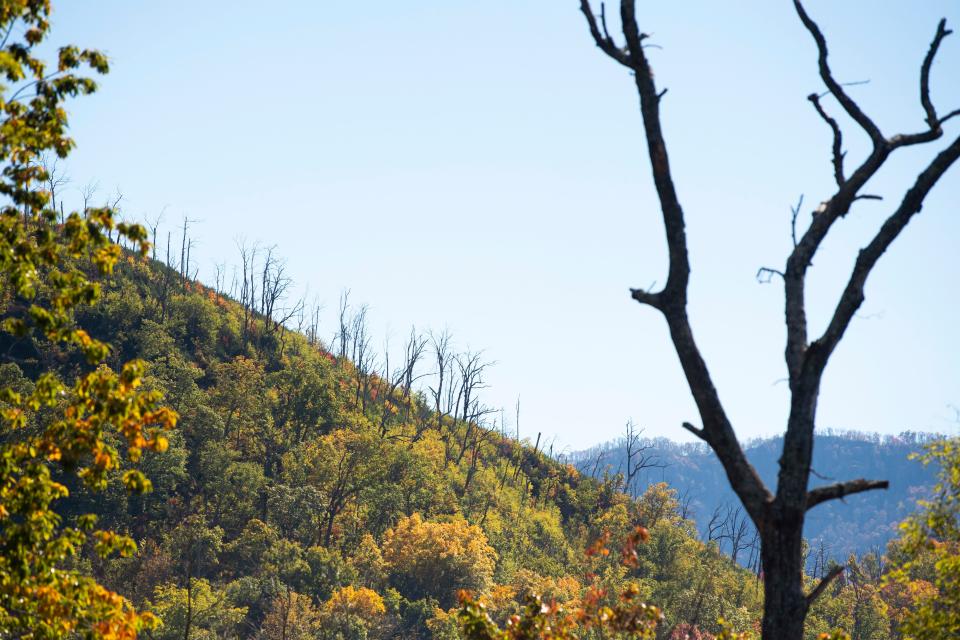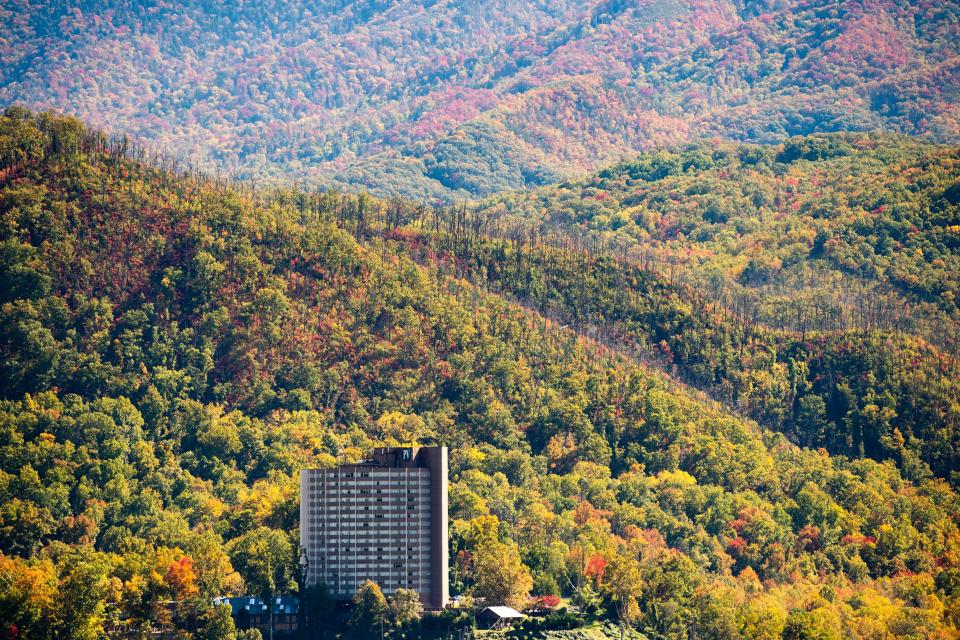The devastation of the Gatlinburg wildfires offered hope, in a way, for scientists
The 2016 Gatlinburg wildfire was deadliest in the eastern half of the U.S. since the Great Fires of 1947 in Maine and the worst in the history of Great Smoky Mountains National Park.
Fourteen people died. 190 were injured. More than 15 square miles burned over the course of 30 days.
But the fire's aftermath is helping reveal how the forests in the storied national park have evolved to burn. And, maybe, even thrive because of fire.
Five years on, Table Mountain pine seedlings are shooting up as saplings for the first time in decades. Short, bushy oaks sprout from roots that survived the heat. Reclusive fungi pop up from the ashen soil. Huckleberry bushes creep in, attracting bears and birds.

Nature persists. It's up to us to learn from it.
Returning forests
After the burn, scientists found something rare and unexpected: a species of nearly extinct tree regrowing in the mountains on the Tennessee-North Carolina border.
"I had no idea there was so much American chestnut up there," said Jennifer Franklin, a professor of forestry at the University of Tennessee Institute of Agriculture. Before the chestnut blight killed most of the American chestnuts in the early 1900s, they dominated eastern forests. Only a few remnant chestnuts survived. "It was amazing because everything else burned off around them."
Franklin studies prescribed burns and forestry. In the years after the fire, she has been trekking into the park to observe which plants survived and returned. She told Knox News she was surprised how quickly the forest began to regenerate even in the hottest burn spots.
The fires of 2016 did not burn equally. In some forested pockets, you could barely tell anything had happened. In the hottest places, all of the leaf litter burned away, leaving bare soil. But scientists learned the fire didn't reach the deepest roots.
"Those root systems that survived, those trees, they just came back really strongly," Franklin said. Chestnuts, oaks, shortleaf pine and Table Mountain pine all returned very quickly. "Some of them we counted over 100 sprouts from a single root system."
Tips from an insider: Best ways to spend time in Gatlinburg and Pigeon Forge: Tips from an insider
More: America's newest national park features a human-made marvel in West Virginia
Franklin has a keen eye for the effects of fire. She teaches up-and-coming foresters prescribed fire management.
National park personnel have been intentionally burning sections of the park since the 1990s, for conservation purposes and to thin out debris. But for a prescribed fire to work as intended it needs to mimic the effects of a natural fire.
"I thought it was interesting that the prescribed fires done in earlier years by the park staff had similar effects to wildfire," Franklin wrote in an email to Knox News. She explained that it was difficult to mimic the effects of more intense wildfire with safe, controlled fires set during the wet season. The 2016 fire revealed that it is possible to get some of the effects of a wildfire without a fire going wild.
Bears sheltered in place
Bears, largely pulled through the fire unscathed. Joseph Clark is an adjunct professor at UT who studies bears that live near humans. He happened to be following a dozen bears wearing radio collars when the fires started. Clark said he was surprised to see that, by and large, the bears didn’t flee the fire. They sheltered in place.
"The fire just seemed to roar over them," Clark said. He explained that only two bears were documented to have died from the fire, one of which was euthanized by the park service. "I think they mostly found enough cubby holes that they could just hunker down and wait for the fire to pass through."
After the fires were contained, the bears ventured into the burned areas possibly seeking carcasses to scavenge.
These behaviors were also seen among bears during and after the 1988 Yellowstone Fires, which means that North American bears may have fire survival instincts in common.
Secretive fungi appear
Perhaps the most unexpected thing the fires revealed was how they affect fungi. In the areas that burned the most intensely, rare, fire-loving fungi were among the first living things to recolonize.
Karen Hughes, a UT professor of mycology, explained that plants rely on symbiotic fungi to grow and thrive.
"Fires of that intensity are supposed to destroy microorganisms in the top eight inches of soil," Hughes said. If the soil was sterile after a fire, pine seedlings shouldn't have been able to grow. "And yet here are these little pine trees coming up."
Hughes and other researchers discovered that the roots of the young pine sprouts were covered in symbiotic fungi. .
"Fungi help modify soil in a way that helps a healthy forest to return," Hughes said.
Mycology experts aren’t sure how these fungi survive the flames. Some fungi might have been carried on the wind, others may have escaped the flames deep in the soil.
Hughes and her collaborators found some of these fire fungi live symbiotically, inside of mosses and trees. Fire rarely burns all parts of a plant evenly and some unburnt plant matter flies off in the fire’s updraft. These unburnt portions may spread the fungi over a burned area, where they later grow into visible mushrooms.
The fire completely remapped where scientists understand many fire-dependent fungi species to live. Some were even unknown in the park before the fire.
"The fact that fire has been suppressed means that we just haven't seen these fungi," said Hughes. She explained that the fire let her see the fungi that had been hiding in the soil, trees and moss. "There were so many of them that they colored the forest floor."
Evolving to burn
Great Smoky Mountains and the greater Southern Appalachians are not strangers to fire. While large blazes like those of 2016 are rare, the park's forests evolved in tandem with smaller, frequent fires. The biodiversity of the park is dependent on different types of forests that burn at different frequencies.
"Table Mountain pine is only found in the central and southern Appalachians and it has cones that have to be heated to fully open and release seeds," said Donald Hagan, an associate professor of forest ecology at Clemson University. "That says something about how long fire has been on this landscape."

Scientists track fire histories using preserved burn scars in old-growth trees and by carbon-dating fossil charcoal. These physical records show that fire used to burn more frequently through the Appalachians than it does nowadays.
Many fires were probably set intentionally. For thousands of years, indigenous people would set blazes for hunting, crop land and trail clearance, and to maintain space for important plants like giant river cane. Cades Cove, in the centuries before European settlement, was routinely burned by the Cherokee to maintain open fields.
In upland areas that regularly burned, oak and pine trees grew over open, grassy forest floors. The trees grew tall to avoid low flames. In the spring, riots of wildflowers emerged.
Each fire's effects rippled through time, felt differently by every plant, tree and animal. For example, a Smokies study found that a fire can affect which birds live where for approximately 25 years after a burn.
For most of the park’s history, both natural and human-caused fire have been suppressed by the Forest Service and the Park Service. Setting fires was discouraged and wildfires were put out.
Over the decades, the parts of the park dominated by fire-adapted species like oak and pine were colonized by moisture-loving species like maples and hemlock. These new species closed off the understory, making the forest thick, shady and moist.
Oak and pine saplings cannot compete under these conditions. Their seedlings are out-competed or never germinate. As the decades wear on they are slowly being replaced.
Many species that depend on these woodlands, like the red-cockaded woodpecker and the purple fringed orchid, are dwindling as the forests change.
"It's a feedback loop, here species encroach and it becomes harder for fire to happen," Hagan said. "That doesn't mean it can't happen but it's only going to happen under a more severe drought."
The fire cycle continues
The other consequence of thick forests is the potential for more damaging fires. During droughts, dry, decomposing leaves become fuel.
Hagan they don't have to be catastrophic fires like the worst seen in Gatlinburg to cause real damage to trees.
"Slow-burning fires feed off of decomposing leaves on the forest floor and cook the upper root systems of many trees. After several years those trees die, leaving behind standing dead trunks.
"That means they are fuel for future fires," Hagan said. "Certain parts of the landscape might be more flammable than they were in 2016."
In the future, the mountains could experience similar conditions to what was recorded in 2016. Scientists project that the Southern Appalachians will experience more intense rainstorms with long periods of drought between them as climate change worsens.

"We are seeing increased climate volatility," Hagan said. "There will certainly be situations where you have extreme droughts that create extreme fire events."
Hagan and other forest ecology experts think that the best way to prepare for this is to promote the natural biodiversity. By creating lots of different sections of forest at different stages of growth, park managers can conserve species and prevent sweeping fires at the same time.
And, of course, prescribed burns are one of the tools, too.
"We know the future is going to be different from the past," Hagan said. "Effectively what we are doing is hedging our bets against an uncertain future."
This article originally appeared on Knoxville News Sentinel: Gatlinburg wildfires exposed lessons in forest life after a blaze

